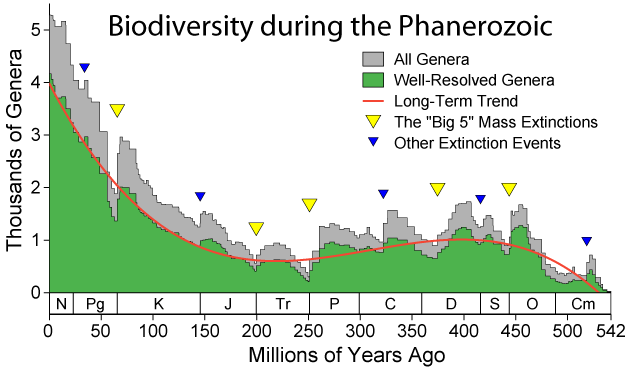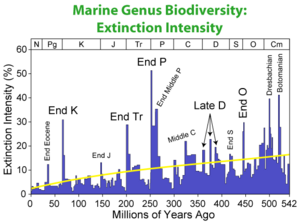File: Phanerozoic Biodiversity.png
Phanerozoic_Biodiversity.png (627 × 371 pixels, file size: 21 KB, MIME type: image/png)
Following Rohde & Muller (2005), this figure shows the apparent changes in marine biodiversity throughout the last 542 million years (the Phanerozoic eon) based on the first and last appearance of the 36380 genera recorded in the Sepkoski Compendium (2002). The "Big Five" mass extinctions of Raup and Sepkoski (1982) are labeled as well as a number of additional, but less well-known extinction events. Conventional symbols for the periods of geologic time appear along the bottom. The distinctions for "all genera" and "well-resolved genera" follow Rohde & Muller (2005) and reflect either the inclusion of all of Sepkoski's taxa or only those where the first and last appearances were well-defined in time.
It is presently a matter of scientific debate whether the long-term trend appearing here is a genuine reflection of biological changes or is instead a reflection of the biases inherent to the process of paleontological investigation. Some have argued that most, or all, of the large rise going into the modern day is merely a reflection of the greater availability and preservation of recent geologic sections. Others dispute this, and argue that most of the long-term changes reflect genuine biological processes.
Rohde & Muller also argue that the fluctuations in biodiversity, especially occurring in the early part of the record, are too regularly spaced to have occurred by random chance. The conclude on the basis of a statistical argument that some unknown process influenced the waxing and waning of life with roughly a 62 million year periodicity. Periodic astronomical and geophysical processes are considered, but no particular process is definitively implicated.
Copyright
This figure was originally prepared by Dragons flight from published data and is released under the GFDL.

|
Permission is granted to copy, distribute and/or modify this document under the terms of the GNU Free Documentation License, Version 1.2 or any later version published by the Free Software Foundation; with no Invariant Sections, no Front-Cover Texts, and no Back-Cover Texts. A copy of the license is included in the section entitled "Text of the GNU Free Documentation License." |
ReferencesISBN links support NWE through referral fees
- Raup, D. & Sepkoski, J. (1982). Mass extinctions in the marine fossil record. Science 215: 1501–1503.
- Rohde, R.A. & Muller, R.A. (2005). Cycles in fossil diversity. Nature 434: 209-210.
- Sepkoski, J. (2002) A Compendium of Fossil Marine Animal Genera (eds. Jablonski, D. & Foote, M.) Bull. Am. Paleontol. no. 363 (Paleontological Research Institution, Ithaca, NY).
File history
Click on a date/time to view the file as it appeared at that time.
| Date/Time | Thumbnail | Dimensions | User | Comment | |
|---|---|---|---|---|---|
| current | 02:45, 22 December 2005 |  | 627 × 371 (21 KB) | Rick Swarts (talk | contribs) | [http://en.wikipedia.org/wiki/Image:Phanerozoic_Biodiversity.png source and rights] |
You cannot overwrite this file.
File usage
The following 3 pages use this file:

